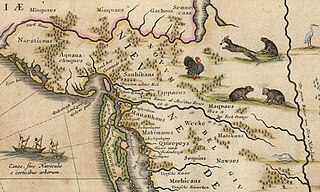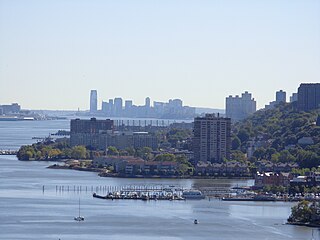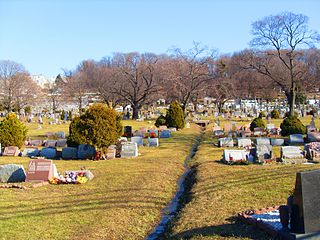
Edgewater is a borough located along the Hudson River in Bergen County, in the U.S. state of New Jersey. As of the 2020 United States census, the borough's population was 14,336, an increase of 2,823 (+24.5%) from the 2010 census count of 11,513, which in turn reflected an increase of 3,836 (+50.0%) from the 7,677 counted in the 2000 census

Fort Lee Historic Park is located atop a bluff of the Hudson Palisades overlooking Burdett's Landing, known as Mount Constitution, in Fort Lee, New Jersey, United States. The park was conceived as early as 1952.

Flower Hill Cemetery is located in North Bergen, New Jersey. It is cojoined with Hoboken Cemetery and Machpelah Cemetery.

The Hudson County Burial Grounds, also known as the Secaucus Potter's Field and Snake Hill Cemetery, is located in Secaucus, New Jersey.

The Gateway Region is the primary urbanized area of the northeastern section of New Jersey. It is anchored by Newark, the state's most populous city. It is part of the New York metropolitan area.

Bergen Hill refers to the lower Hudson Palisades in New Jersey, where they emerge on Bergen Neck, which in turn is the peninsula between the Hackensack and Hudson Rivers, and their bays. In Hudson County, it reaches a height of 260 feet.

The Hudson River Waterfront Walkway, also known as the Hudson River Walkway, is a promenade along the Hudson Waterfront in New Jersey. The ongoing and incomplete project located on Kill van Kull and the western shore of Upper New York Bay and the Hudson River was implemented as part of a New Jersey state-mandated master plan to connect the municipalities from the Bayonne Bridge to the George Washington Bridge with an urban linear park and provide contiguous unhindered access to the water's edge.

Bergen was a part of the 17th century province of New Netherland, in the area in northeastern New Jersey along the Hudson and Hackensack Rivers that would become contemporary Hudson and Bergen Counties. Though it only officially existed as an independent municipality from 1661, with the founding of a village at Bergen Square, Bergen began as a factory at Communipaw circa 1615 and was first settled in 1630 as Pavonia. These early settlements were along the banks of the North River across from New Amsterdam, under whose jurisdiction they fell.

The Old Bergen Church is a historic church congregation in Jersey City, Hudson County, New Jersey, United States. Established in 1660 in what was then the Dutch colony of New Netherland, it is the oldest continuous religious congregation in what is today the State of New Jersey. The congregation is jointly affiliated with the Reformed Church in America and the Presbyterian Church (USA). The church was added to the National Register of Historic Places on August 14, 1973. The original church building was constructed in 1680 and the current edifice was built in 1841.

Burdett's Landing, also called Burdett's Ferry, is a site on the west bank of the Hudson River located in Edgewater, New Jersey. Ferries initially used Burdett's Landing as a departure point for transporting agricultural produce from New Jersey across to New York. In the Revolutionary War it played a role in the movement of American supplies and soldiers, and in the 19th century it served as a landing for steamboats. There is no longer a wharf or ferry service at the landing.
Mollie Sneden born as Mary Dobbs was the operator of a ferry service at Palisades, New York, in the United States, before and after the American Revolution. During the war she was prohibited from running the ferry because of her British sympathies. Mollie Sneden is listed as a Woman of Distinction by the New York Senate.

The Hudson Waterfront is an urban area of northeastern New Jersey along the lower reaches of the Hudson River, the Upper New York Bay and the Kill van Kull. Though the term can specifically mean the shoreline, it is often used to mean the contiguous urban area between the Bayonne Bridge and the George Washington Bridge that is approximately 19 miles (31 km) long. Historically, the region has been known as Bergen Neck, the lower peninsula, and Bergen Hill, lower Hudson Palisades. It has sometimes been called the Gold Coast.

The Weehawken Cemetery, like neighboring Hoboken Cemetery, is not located in its namesake town of Weehawken but rather on the western slope of the Hudson Palisades in North Bergen, New Jersey, with its main entrance on Bergen Turnpike. At its east side the cemetery is overlooked by the Bergen Crest Mausoleum and the Garden State Crematory. and nearby Flower Hill Cemetery.

The Grove Church Cemetery is a nonsectarian cemetery, located on the western slope of the Hudson Palisades, along with several other cemeteries in a string of green open space, in Hudson County, New Jersey, United States. The Grove Church, who owns the cemetery, is one of the oldest religious bodies in the area, and it has had an operating cemetery since 1847. Throughout its history, prominent families have been buried there, as well as American Civil war veterans. There have also been reports of vandalism and misuse of the property since the 19th century, and in 2007 some of the cemetery grounds were occupied by the homeless.

The Alcoa Edgewater Works was located in Edgewater, Bergen County, New Jersey, United States. The building was built in 1916 for the Alcoa company and added to the National Register of Historic Places on August 10, 1978. The building has since been demolished.

The Ford Motor Company Edgewater Assembly Plant was located in Edgewater, Bergen County, New Jersey, United States. The factory began operations in 1930 and was closed in 1955, having been replaced by the Mahwah Assembly plant. The building was built in 1929 and added to the National Register of Historic Places on September 15, 1983, located at 309 River Road. The building was torn down in 2006 and replaced with a residential development.

Fairview Cemetery, also known as Fairview Memorial Park and Mausoleum, is a burial ground in Fairview, Bergen County, New Jersey in the United States, located on the western slopes of the Hudson Palisades. It is bordered by North Bergen, Broad Avenue, and Fairview Avenue, across from which is Mount Moriah Cemetery. The New York, Susquehanna and Western Railroad right-of-way at western portal of the Edgewater Tunnel passes through the cemetery.

The Edgewater Branch was a branch of the New York, Susquehanna and Western Railway (NYS&W) that ran about 3.174 miles (5.108 km) through eastern Bergen County, New Jersey in the United States. Starting from a rail junction at the Little Ferry Yard, it went east through the Edgewater Tunnel to Undercliff to the Hudson Waterfront.

















